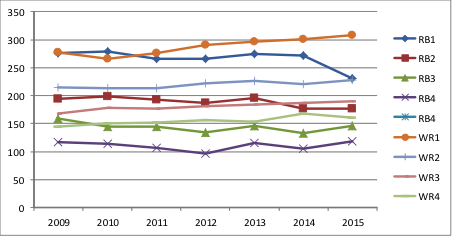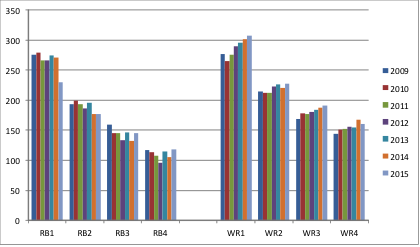Simply put, the WR heavy draft approach famously outlined in the landmark RotoViz article ‘Zero RB, Antifragility, and the Myth of Value-Based Drafting‘ by Shawn Siegele is the optimal draft strategy in fantasy football. The risks associated with taking running backs – namely injury and possible timeshares – in the early rounds makes those situations easier to avoid as the years roll by. Wide receivers are just better at scoring fantasy points than running backs. Receivers are often the most and athletic players on the field, easier to project and safer in negative game scripts, and less likely to sustain a serious injury. Most importantly, the already superior production coming from wide receivers continues to increase.
Fantasy Point Scoring Trends
Below illustrates the average PPR scoring via SportingCharts from 2009-2015 from the top-four groups (1-12, 13-24, 25-36, 37-48) of both wide receivers and running backs.


-The average WR1 scored more than 300 fantasy points each of the last two years.
-RB1s peaked at 279 points in 2010. Last year’s running back apocalypse saw RB1s drop to a level just above WR2s.
-WR2s have easily outscored RB2s every year.
-WR3s have outscored RB2s the last two years by nearly seven percent.
| 2009 | 2010 | 2011 | 2012 | 2013 | 2014 | 2015 | |
| RB1 | 275.4 | 279.0 | 265.9 | 265.8 | 274.1 | 271.6 | 230.4 |
| RB2 | 193.9 | 198.9 | 192.9 | 186.3 | 195.5 | 176.4 | 176.9 |
| RB3 | 159.8 | 145.0 | 144.8 | 133.8 | 146.8 | 132.6 | 145.6 |
| RB4 | 116.8 | 114.1 | 107.4 | 96.2 | 115.2 | 105.3 | 117.8 |
| WR1 | 276.8 | 265.3 | 275.3 | 290.3 | 295.8 | 301.5 | 307.4 |
| WR2 | 214.9 | 212.7 | 212.6 | 222.7 | 225.8 | 220.8 | 227.5 |
| WR3 | 168.6 | 178.0 | 176.8 | 180.7 | 184.4 | 187.1 | 190.6 |
| WR4 | 144.3 | 151.2 | 151.9 | 156.4 | 154.1 | 168.0 | 160.2 |
Even if you excuse what happened to running backs last year RB1 production has plateaued at the 250-260 level, and there’s little reason to believe that’s going to change. However, what’s happening at the next tier is even more alarming. The sharp decline in RB2 production started two seasons ago. Third tier wide receivers have surpassed second tier running backs. Blowing an early round pick on a running back that underperforms has never been more disastrous. This is why hunting for those rare RB1 dragons in the early rounds just doesn’t make sense anymore. Getting it wrong on an early running back means he may not even equal the third-rate production from a wide receiver.
High Ceiling, High Ceiling
Zero RB is really all about taking the best players, and best players are wide receivers. Today’s top-10 wide receivers are doing what top-five wide receivers did back in 2010 and 2011. Zero RB says invest your most important picks at the most important position. This maximizes the chances of landing more of the players that are scoring the most fantasy points while embracing the fragile nature of running back forecasting. It’s really that straightforward.
The fork in the road where many are veering away from a true Zero RB approach is once all the WR and Flex slots are occupied by wide receivers. A true anti-fragile, Zero RB approach says to keep going with wide receivers for at least another round or two to build a wide receiver stronghold. These added layers provides a number of key things:
-insurance against injury and underperformance.
-flexibility to exploit weekly matchups, especially during the bye weeks.
-a strong bench wide receiver is one that isn’t be started by your opponent.
-depth in which to potentially trade from.
-easier draft preparation.
Conclusion
Perhaps the secret cause for some of the Zero RB pushback is that the strategy can be so effective, yet is so simple. Wide receivers are the best players, so just draft a bunch of them! Then, exploit all the holes in the running back position. First by avoiding the early and frequently overvalued RBs when stocking up on all of those WRs. Second, grab the undervalued potential workhorse running backs like Melvin Gordon and LeGarrette Blount. Then spice in PPR-friendly pass catching backs from Theo Riddick to Shane Vereen to Chris Thompson to Shaun Draughn while also attacking the contingency RBs that are an injury away from a huge season such as Charles Sims, Tevin Coleman, and Jerick McKinnon. Finally, append your roster with late round selections at quarterback and tight end, and viola! A very streamlined, optimal drafting method.


